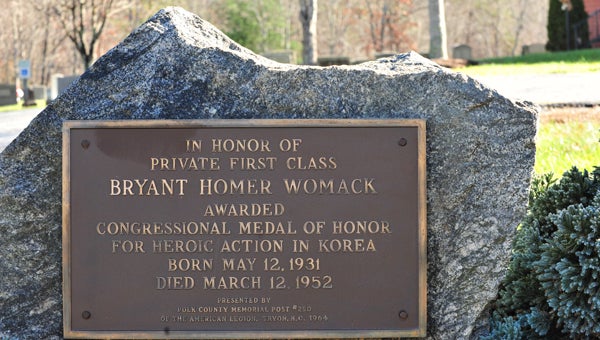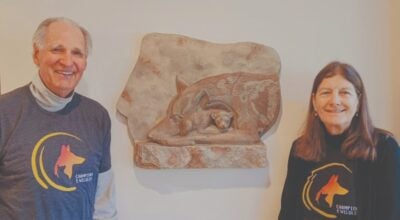Bryant H. Womack
Published 11:24 pm Sunday, May 1, 2016
Renovating a gravesite rekindles memories of young Mill Spring Army medic
Written by Mark Schmerling
Photographs by Mark Schmerling and Leah Justice
Bryant Womack might be with us today had he not lost his life as a battlefield medic in the Korean War in 1952, under circumstances that suggest he understood — and lived – the ideal of service to others, and to an exceptional degree.
His actions, and those of so many other servicemen and women, highlight the importance of Memorial Day, to be observed this May 30, and which led a group of veterans from American Legion Post 250 in Tryon to renovate and spruce up the gravesite of Polk County’s only Congressional Medal of Honor recipient.
Frank Ortiz, a retired colonel and a Korean War veteran himself, and Darryl Moore, Polk County’s Veterans Service Officer, have, over the past winter and spring months, worked hard to keep Womack’s legacy alive by helping to upgrade the final resting place for the young soldier at Lebanon United Methodist Church. The church is on Big Level Road, not far from where Womack lived, on ground once owned by Womack’s family.
According to Moore, “There are still people in the county who remember him … a hard-working farm boy.” Womack grew up near Pea Ridge, and attended Sunny View School. Some of that land, along Womack Road, between Big Level and Polk County Line roads, remains in the family.
Early in 2015, Ortiz, Moore and others from the American Legion planned a renovation at Womack’s gravesite. At that time, Moore recalled, “We thought it looked pretty shabby.”
Gravesites of military veterans usually bear a plaque or a headstone. Moore pointed out that in the case of Medal of Honor winners, they get a lot more. At Womack’s grave, the plaque was renovated. Marble chips replaced gravel, and a rubber underlayment helps prevent the growth of weeds. Clayton Monuments, located in Landrum, provided assistance at a reduced price because Womack was a Medal of Honor recipient.
The gravestone itself, the standard head marker from the Department of Veterans Affairs, was re-done. “We thought it was important to keep the original stone,” Moore noted. “In traditional military fashion, it’s kept simple.”
Womack’s grave, next to that of his parents, George and Julia, is among many in the church cemetery. A plaque at its foot describes him as a Medal of Honor recipient. The stone, marked Bryant Homer Womack, also lists his birth and death dates, and that he served in Korea in the 14th Infantry. Unlike other gravesites in the cemetery that are marked simply by headstones, Womack’s site is bordered in white, and its surface covered in white marble chips, making it stand out in contrast to others.
Would anyone have been able to know that the young enlistee from Pea Ridge, in just his short life and time in the military, would have stood out as he did? That his actions would garner him the Congressional Medal of Honor and buildings in both Polk County (Bryant H. Womack Justice and Administration Building) and at Fort Bragg (Womack Army Medical Center) named for him?
Photographs in the Womack Building in Columbus show the lanky young man playing a guitar and a banjo. He also enjoyed hunting, fishing and riding bicycles. Even today, the family land enjoys the kind of rural peace that draws so many to Polk County, and keeps so many here. All three roads are lightly traveled, with the lower Green River passing quietly near the bucolic scene, much the same as when Womack lived.
In fact, the day Womack answered his draft call, according to his sister Rachel Elliott, he had been plowing the fields until noon. Moore pointed out that Womack, who never married, went straight from the family farm into the Army, and then to Korea.
Visitors to the Womack Building can read the memorial statement to Womack, describing how the Congressional Medal of Honor winner, risked, then sacrificed, his own life, to provide battlefield medical aid to his wounded comrades, even after he’d received wounds that proved fatal.
That citation notes that Womack “distinguished himself by conspicuous gallantry above and beyond the call of duty . . .” It states, “Private Womack was the only medical man attached to a night combat patrol when sudden contact with a numerically superior enemy produced numerous casualties.”
Immediately rushing to aid his wounded comrades, Womack knew he was . . . “exposing himself to a devastating hail of enemy fire, during which he was seriously wounded . . .”
Refusing medical aid for himself, Womack “continued moving among his comrades to administer aid. While he was aiding one man, he was again struck by enemy mortar fire, this time suffering the loss of his right arm.”
Even knowing the consequences of refusing aid for himself, Womack “insisted that all efforts be made for the benefit of others that were wounded. Although unable to provide aid, Womack remained on the scene and directed others in first aid techniques. The last man to withdraw, he walked until he collapsed from loss of blood, and died a few minutes later while being carried by his comrades,” the citation continues.
Those actions took place near Sokso-ri, Korea, on March 12, 1952. Womack was then a private first class, with the Army Medical Service Medical Company, 14th Infantry Regiment, 25th Infantry Division. He was two months shy of his 21st birthday.
The citation notes young Womack’s “extraordinary heroism, outstanding courage, and unswerving devotion to his duties . . . reflect the utmost distinction upon himself and uphold the esteemed traditions of the U.S. Army.”
Several years ago, local honored World War II veteran Howard Greene (still living) told Polk County commissioners of how he met Womack when both were stationed at the same Army camp. Greene recalled that Womack told him he wanted to be a medic because he couldn’t stand the idea of killing. Greene said he begged Womack not to be a medic, as he (Greene) had seen so many medics killed.
“He wouldn’t listen to me,” Greene related.
Moore noted that, during military basic training, young servicemen and women become very close. “That’s how these guys can leap on a grenade to save their comrades,” Moore said.
# # #






